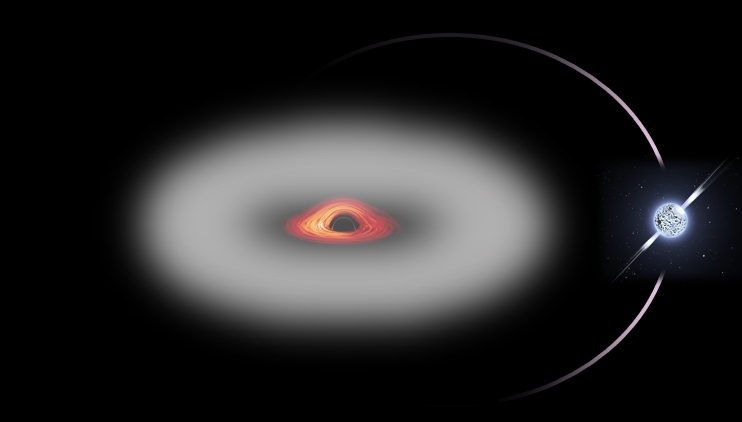Black Hole Superradiance

General Idea
The main motivation for studying black hole (BH) superradiance is to explore how astrophysical objects with strong gravitational effects can be used to probe particles beyond the Standard Model (BSM), which interact only weakly with baryonic matter. A rotating BH can generate an ultralight boson cloud through purely gravitational interactions, forming a so-called “Gravitational Atom” (GA), which is called superradiance instability. This structure can produce observable imprints, such as gravitational wave (GW) signals, that carry information about the properties of these ultralight BSM particles.
When a GA has a binary companion, even more interesting phenomena can arise. For example, if the orbital frequency of the companion matches the energy difference between two GA eigenstates, a Landau-Zener resonance transition can occur. This induces transitions between eigenstates, allowing the GA to exchange energy and angular momentum. Such changes create a backreaction on the binary companion, altering its orbital motion—an effect that could be detectable through various observational channels. This provides an alternative method to confirm the existence of such BSM bosonic particles.
Furthermore, when the binary companion lies within the boson cloud, ionization (or dynamical friction) can be more efficient than GW emission in depleting the orbital energy. Additionally, the presence of the binary companion can influence the growth rate of the cloud itself. Please check my publications below for more details.
My Research Interest
My research focuses on how binary companions can influence the properties of black hole superradiance and gravitational atoms. For example, we found that the tidal effects caused by a binary companion can significantly alter the growth rate of the scalar cloud. If the binary separation is small enough or the companion mass is large enough, superradiance can even be terminated. In this case, the cloud is reabsorbed by the black hole, causing the gravitational atom to lose its energy. This process backreacts on the binary companion, modifying its orbital parameters. Follow-up work on this topic can be found in my publication list below.
In a recent study, we used supermassive black hole (SMBH) binaries to probe ultralight bosons (ULBs) without relying on dark matter assumptions, placing new constraints on ULB mass. A superradiant ULB cloud formed around a spinning SMBH can accelerate binary mergers through cloud-induced dynamical friction, especially at final-parsec separations. By analyzing the orbital decay of the century-monitored OJ287 binary system with our model, we derived a novel constraint on the ULB mass. This additional energy dissipation mechanism also suppresses the stochastic gravitational wave background, introducing a turnover feature in the nanohertz band. Our theory is testable with future pulsar timing array data and precision measurements of SMBH binary orbits.
Publications
- Q. Ding, M. He, V. Takhistov, and H. Y. Zhu, “Superradiant Bosons Driving Supermassive Black Hole Mergers”
- H. Y. Zhu, X. Tong, G. Manzoni, and Y. Ma, “Survival of the Fittest: Testing Superradiance Termination with Simulated Binary Black Hole Statistics”
- K. Fan, X. Tong, Y. Wang, and H. Y. Zhu, “Modulating binary dynamics via the termination of black hole superradiance”
- X. Tong, Y. Wang and, H. Y. Zhu, “Termination of superradiance from a binary companion”
- X. Tong, Y. Wang and H. Y. Zhu, “Gravitational Collider Physics via Pulsar–Black Hole Binaries II: Fine and Hyperfine Structures Are Favored”
